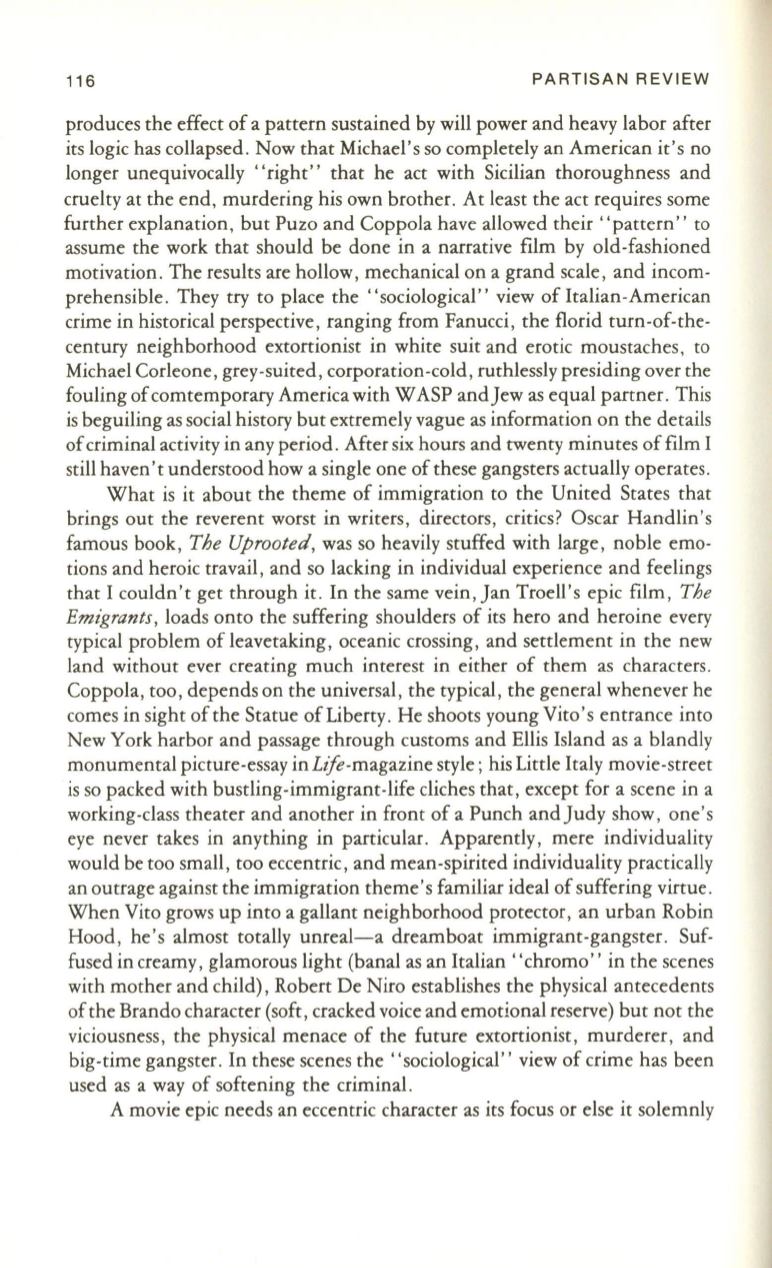
116
PARTISAN REVIEW
produces the effect of a pattern sustained by will power and heavy labor after
its logic has collapsed. Now that Michael's so completely an American it's no
longer unequivocally "right" that he act with Sicilian thoroughness and
cruelty at the end, murdering his own brother. At least the act requires some
further explanation, but Puzo and Coppola have allowed their "pattern" to
assume the work that should be done in a narrative film by old-fashioned
motivation. The results are hollow, mechanical on a grand scale, and incom–
prehensible. They try to place the "sociological" view of Italian-American
crime in historical perspective, ranging from Fanucci, the florid turn-of-the–
century neighborhood extortionist in white suit and erotic moustaches, to
Michael Corleone, grey-suited, corporation-cold, ruthlessly presiding over the
fouling ofcomtemporary America with WASP andJew as equal partner. This
is beguiling as social history but extremely vague as information on the details
ofcriminal activity in any period. After six hours and twenty minutes of film I
still haven't understood how a single one of these gangsters acrually operates.
What is it about the theme of immigration to the United States that
brings out the reverent worst in writers, directors, critics? Oscar Handlin's
famous book,
The Uprooted,
was so heavily stuffed with large, noble emo–
tions and heroic travail, and so lacking in individual experience and feelings
that I couldn't get through it. In the same vein, Jan Troell's epic film,
The
Emigrants,
loads onto the suffering shoulders of its hero and heroine every
rypical problem of leavetaking, oceanic crossing, and settlement in the new
land withour ever creating much interest in either of them as characters.
Coppola, too, depends on the universal, the typical, the general whenever he
comes in sight of the Statue of Liberty. He shoots young Vito's entrance into
New York harbor and passage through customs and Ellis Island as a blandly
monumental picture-essay in
Ltle-magazine
style; his Little Italy movie-street
is so packed with bustling-immigrant-life cliches that, except for a scene in a
working-class theater and another in front of a Punch and Judy show, one's
eye never takes in anything in particular. Apparently, mere individuality
would be too small, too eccentric, and mean-spirited individuality practically
an outrage against the immigration theme's familiar ideal of suffering virtue .
When Vito grows up into a gallant neighborhood protector, an urban Robin
Hood, he's almost totally unreal-a dreamboat immigrant-gangster. Suf–
fused in creamy, glamorous light (banal as an Italian" chromo" in the scenes
with mother and child), Robert De Niro establishes the physical antecedents
of the Brando character (soft, cracked voice and emotional reserve) but not the
viciousness, the physical menace of the future extortionist, murderer, and
big-time gangster. In these scenes the "sociological" view of crime has been
used as a way of softening the criminal.
A movie epic needs an eccentric character as its focus or else it solemnly


